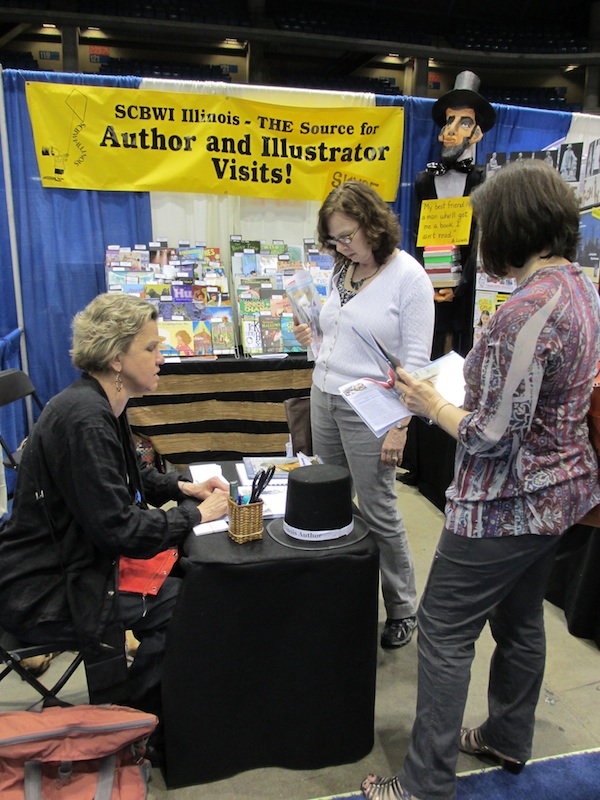Tomorrow morning Whitney and I head to Skokie for a “Mix ‘n Mingle” at National Louis University. Twenty children’s book authors have been invited to display our wares to school librarians who’ll be there, and before the mingling starts we each get one minute to stand by our table and give a summary of what we do during school presentations.
the event coordinator warned us she’ll be using the stopwatch on her IPhone to keep our speeches short. “What do you wish to accomplish — book school visits? increase the visibility of your books?” she wrote in an email. “Plan out your 1 minute in advance…and I do mean ONE minute!”

That's me at a booth at the IRC conference last March. Whitney's under the table. (Photo by Cheryl May.)
This consists of a slate or template with evenly spaced depressions for the dots of Braille cells, and a stylus for creating the individual Braille dots. With paper placed in the slate, tactile dots are made by pushing the pointed end of the stylus into the paper over the depressions. The paper bulges on its reverse side forming “dots.”
Huh? Obviously using a slate and stylus to create Braille is something you need to see – or feel – in order to understand how it works.
The librarians who stop by our booth tomorrow will get a bookmark of the Braille alphabet to help them “decode” the word I’ve brailled out for them. I’m hoping they’ll share these treasures with their students back home and conjure up ways to use the concept of Braille to encourage the kids to read print. And then, well, they’ll just have to invite Whitney and me to come visit: I read from a Braille version of my children’s book Hanni and Beth: Safe & Sound at all our school presentations.
Gotta go now and gather up all the Braille and print stuff to bring along tomorrow and practice that one-minute summary. Who knows? I may even learn to use the stopwatch on my talking iPhone!
Great photo of you, Beth. You look most professional, as indeed you are. Have a great time. See you next month.
Catherine
Must admit I am relieved that the first comment here compliments the photo there –Mike is so busy arranging for the conference next week that I had to find a photo and put the html coding for it in this blog post myself – he is usually my graphic editor.
Uh-oh. Now I’m worried. I didn’t put the photo of Isabella Rossellini there instead, did I?!
Have a good trip, you two. This post makes me wonder if there are any concerns about Braille “dying” in the so-called digital age
Good question, Siobhan. A little known fact about Braille: fewer than 20% of the 50,000 blind children in the United States are proficient in Braille. All too often, the “written word” has been inaccessible to kids who are blind. They listen to audio books instead, or hear words from a computer screen equipped with a screen reader. Technology is cool, but how will these children ever learn to spell correctly? How will they know where to put commas, quotation marks, paragraph breaks and so on?
Then again, judging from the way sighted kids spell when they text, maybe that doesn’t matter much anymore.
Beth, you didn’t mention the fact that when poking out braille with slate and stylus, one has to poke out the letters and words in reverse. So you not only has to learn a new alphabet, but need learn it backwards and forwards. To me, that is really incredible that someone can learn to do that. Oh, and have a great trip!
I have a disease of my sympathetic nervous system that causes severe chronic pain in my dominant hand. The physical therapist who’s been working with me for years recently found an article suggesting that, among other things, learning braille, might help to re-wire my brain to not “over react” to sensations. Interesting… Here’s a link to the full article: http://www.rsds.org/pdfsall/Groopman_newyorker_2005.pdf
Have fun in Denver!
The above article says that learning braille, learning to do new tactile activities, has been shown to rewire the brains of stroke patients (and possibly people like me.) Sorry for the windy comment above. I thought I hit delete!
No need to apologize, Kim. I found the information –and the link –very interesting. Thanks for sharing!
Only one sentence had to do with braille. I’m glad you didn’t feel like I was over-sharing. I sure did! Hence my effort to delete.
Hava is right, you *do* have to write Braille backwards when using a slate and stylus, so I bet it’s true that learning to read and write Braille rewires parts of the brain.
One might say that in mycase, that explains a lot !
Hope you wre able to figure out the stopwatch app. How’d your one minute go?
I love the idea of the Braille bookmarks and having to use the Braille alphabet to decode a word.
Leave a Response